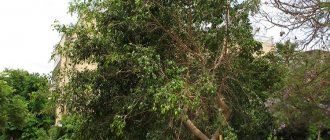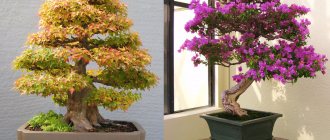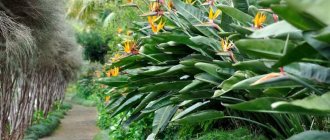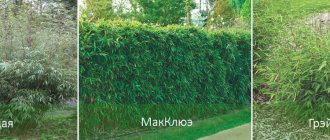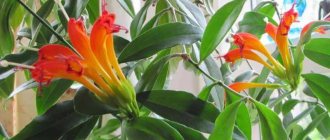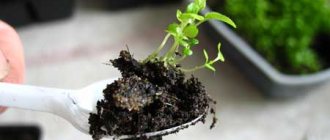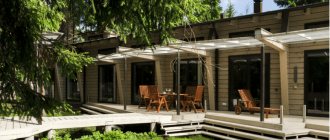Among the many decorative deciduous crops, ficus stands out for its unpretentiousness and diversity of species. These plants are grown in the form of a tree, in the form of a banyan tree, braiding the roots into whimsical patterns, or form a bonsai. The culture easily tolerates conditions that are not the most favorable for itself, but still the best specimens grow only with proper handling. Let's understand the intricacies of caring for ficus benjamina at home.
Ficus benjamina indoors - description
Ficus benjamina belongs to the genus Ficus of the Mulberry family. This evergreen plant is an elegant tree or shrub with small leaves and thin slender stems. In the wild it grows in Asia and northern Australia, preferring to settle in damp forests and foothills.
The height of Ficus Benjamin can reach 30 m, but at home it rarely grows more than 2 m. There are also more compact varieties up to 50 cm in height. At the same time, the growth rate of this species is not rapid, but a home tree can easily add about 20 cm in a year New branches appear from any dormant bud on the trunk and branches, creating a lush and beautiful crown.
The trunk of Ficus Benjamin is slender and graceful. The stem and branches of the plant are covered with thin light brown textured bark. Typically the plant forms only one trunk with many thin and flexible branches. This feature gives Ficus benjamina a resemblance to a birch tree, which is why people have given it the affectionate name “Ficus birch”. The branches of the plant actively branch and are densely covered with beautiful leaves.
Benjamin leaves are small, thin, oval-shaped with a pointed end. The color of the leaves can be very diverse. In nature, the color range of leaf blades of this species is represented by dark shades of green, but varieties of Ficus benjamina can boast a wider palette of shades. Various varieties with leaves of light green and light green, decorated with spots and veins of yellow, cream and white colors are very popular among gardeners.
At home, Ficus Benjamina does not form aerial roots, but in the wild, their roots are so numerous and bizarre that they form entire thickets in which an adult can easily walk. Such trees are called banyan trees and they look really impressive.
Does it bloom?
Few gardeners have ever seen Ficus Benjamin bloom. This plant is valued for the beauty of its crown, but in nature or special greenhouses it may well please with its flowering. The flowers of this tree resemble round peas in appearance and are called syconia. They form at the ends of branches and are a great test for a weakened tree, so in greenhouses and winter gardens they prefer to simply remove the inflorescences that appear.
How many years does he live?
The homemade Ficus Benjamina can live more than 15 years, but in nature the age of some of its specimens is many decades. With proper care, this spectacular tree can live for a very long time and even be passed on to future generations.
Features of the plant
In nature, this plant is found in tropical and subtropical climates. It is found in the forests of China, India, Australia, and Malaysia. The bush grows up to 3 m in height, and in natural conditions up to 30 m; in one year it grows by about 20 cm. It has elongated glossy green leaves with light stripes and small spots.
Some give this tree shape. Its flowers appear small and rather inconspicuous; they grow in a small capsule. Indoor plants usually do not bloom; this process is observed only in greenhouses.
How to care for ficus benjamina at home
Flower growers fell in love with Benjamin for his simple character. If you follow a few rules, this plant will be a worthy decoration for your home’s green corner.
Lighting
Ficus benjamina requires plenty of sunlight when growing, but the plant does not tolerate direct sunlight. It can be placed on the windowsill of an eastern or western window, and larger specimens can be placed near southern windows. On a northern window, due to lack of light, growth slows down and the crown thins out.
Varieties whose leaves are decorated with many light spots require much more light, otherwise they will begin to lose their beautiful color. Such specimens may require additional lighting with fluorescent lamps or special lamps for plants.
Temperature
The Benjamin tree is quite thermophilic, but can easily grow at normal room temperature. The optimal maintenance temperature in the warm season is about +18-+250C. In winter, the temperature in the room should not fall below +160C. The plant does not tolerate drafts, so to prevent the flower from freezing, it is taken to another room during ventilation, since the plant sheds its leaves when exposed to cold air.
It should be borne in mind that variegated varieties of Ficus benjamina need warmer maintenance and are extremely critical of temperature changes.
Humidity
The room where Ficus benjamina grows should have high humidity. It can grow at normal humidity typical of a living room, but you need to regularly spray the crown with warm water from a spray bottle. The leaves of the tree dry out from the hot air when heating devices are operating, so in winter it is removed away from the radiators. You can increase the humidity using a household humidifier; you can also place a flower pot on a tray with expanded clay or wet moss.
Watering
Water the Benjamin tree abundantly, but without allowing the substrate to become waterlogged. Water for irrigation should be soft, at room temperature.
In summer
In the warm season, water every 3-4 days. Watering should be plentiful, as the contents of the pot dry out 3 cm deep. The earthen ball should not be allowed to dry out, as in this case the growth of Ficus Benjamin will stop and it will begin to lose leaves.
in winter
In winter, watering is reduced to moderate. The soil in the pot is moistened approximately once a week, as the top layer dries.
Fertilizer and feeding
From March to October, Ficus Benjamina needs special feeding. Fertilizers are applied 2 times a month, and you can use complex mineral fertilizer or alternate it with organic matter.
When choosing a preparation, it is important to pay attention to the ratio of components, since a high nitrogen content can lead variegated varieties to a completely ordinary monochromatic appearance and loss of characteristic spots. In flower shops you can find special fertilizers for ficus plants. Agricola for Ficus benjamina can be an excellent feeding option. It is used according to the instructions, strictly observing the dosage.
Fertilizers can be applied to the soil or on the leaves. For this you can also use special preparations and mineral fertilizers, but in weaker concentrations.
Special feedings will help not only stimulate the growth of the flower, but also help it recover after a change of place of residence or illness. In order for the plant to better withstand stress, it is sprayed and watered with succinic acid or epin. Succinic acid for Ficus Benjamin serves as a good antidepressant and helps to recover, even if it has lost most of its leaves. It is diluted with water and applied along with watering or sprayed on the crown in a more reduced concentration. After some time of this “therapy”, the ficus comes to life again and begins to actively grow green mass. How to breed Epin for Ficus benjamina can be found in the instructions. This drug has a complex effect and is used for many indoor and garden crops. Just 3-4 drops per 1 liter of warm water are enough to water the bush, after which it regains its vibrant appearance and gradually regains its attractiveness.
Pruning and crown formation
Ficus benjamina lends itself well to pruning and crown shaping. You can create a beautiful shape simply by periodically removing overgrown branches. Usually the plant is given the shape of a lush bush, every spring shortening the main branches to 15 cm and the side branches to 10 cm. The bush will quickly restore its shape and begin to actively increase the lost volume. All branches growing inside the crown are pruned so as not to disrupt air circulation.
To give the Ficus benjamina the shape of a beautiful tree, remove all the side branches on the main trunk. For uniform development of the crown, you need to periodically turn the flower pot in relation to the light source, then the ficus will develop evenly on all sides.
If you need to stimulate the growth of lateral branches on the trunk, you can resort to a little trick and use special means. Cytokinin paste for Ficus Benjamin serves as a stimulator for the awakening of dormant buds. She does an excellent job even if the bush has been significantly damaged by a draft or improper care. To do this, just make small cuts on the trunk of the plant and apply a small drop of paste onto them with the tip of a toothpick. After some time, new branches will begin to appear on the trunk. Just keep in mind that cytokinin paste stimulates the growth of new shoots, but in order for them to grow and develop well, the plant must be well fed and provided with everything necessary for vigorous growth, otherwise new branches will grow disproportionately and may disrupt the decorative appearance of the Benjamin tree. Also, when using special means in variegated varieties, new branches often grow with monochromatic leaves.
How to braid a trunk
The thin and graceful stems of Ficus benjamina are often used to create real living sculptures. The beautiful columns of intertwined trunks of this plant look very attractive, while the ficus does not suffer at all and continues to grow. Weaving Ficus Benjamin is not a complicated process, but it requires a lot of patience, since the formation of an openwork trunk does not occur in a few days, it will take months and even years.
To do this, you need to take several ficus cuttings and plant them in one pot. The planting density depends on the desired result: if you need to tightly intertwine the stems to get a tight twisting trunk, then the seedlings are planted close to each other, at a distance of only 5-10 cm, and when creating an air column, the distance can be increased.
As the seedlings grow, they are braided, secured with plaits and tied with electrical tape. Tightly planted plants are carefully twisted in a spiral and secured. Over time, they will grow together into one dense and beautiful trunk.
Openwork columns are created by crossing and securing young ficus trees. In the middle of the plantings, it is advisable to place a pipe made of plastic or cardboard, around which patterns will weave. In this case, you need to constantly remove all excess lateral growth, leaving leaves and twigs on the crown. The stems are crossed at the desired distance from each other and secured with strands. After they grow together, the tourniquets are removed. For such a composition, it is advisable to plant at least 5 seedlings. More complex and beautiful ornaments are obtained by using 8-10 young plants.
Briefly about care
Temperature in summer +18º - +25º, in winter from +16º Air humidity is high Lighting is moderately bright, diffused Where to put the eastern, south-eastern, western, south-western, southern window sill Watering in summer 2 times a week, in winter - 1 time a week soil with sand and coal Feeding and fertilizing once every 14 days from spring to autumn with organic and mineral preparations Replanting annually in spring Propagation by cuttings, layering, seeds
Reproduction
It is quite easy to propagate Ficus benjamina at home. To do this, just cut off a small branch and root it in water, and then plant it in the substrate. You can also use the layering method, and enthusiasts can try to grow beautiful and rare varieties from seeds.
Cuttings
Cuttings are the easiest and fastest way to get a new bush. To do this, separate a twig 8-10 cm long. It is advisable to choose not young green twigs, but semi-lignified ones. Drops of milky juice are removed from the cutting site, the cuttings are placed in a glass of water and covered with a transparent cap. As a rule, after 1-2 weeks the first roots will begin to appear. When they grow to 5 cm, the seedlings are planted in a pot with substrate.
By layering
A small circular cut is made on a bare branch, wrapped in damp moss, and covered with a transparent film on top. The film is secured at the top and bottom with thread or soft wire. From time to time you need to moisten the moss; to do this, open the film from above and drop a couple of drops of water under it. As roots begin to appear on the stem, the branch is cut off and rooted in a pot with substrate.
Seeds
New varieties of Ficus benjamina can be grown from seeds. To do this, the material is pre-soaked for a day in warm water, then sown in a peat-sand mixture. The seeds are planted to a depth of 0.5 cm, sprinkled with earth, covered with film and placed in a warm, bright place. For germination, seeds are kept at a temperature of +25-+270C. The film is removed daily for 10-15 minutes, the greenhouse is ventilated and, if necessary, the surface of the substrate is moistened with a spray bottle. When the first shoots appear on the soil surface, the film is removed. The seeds may take about 2-3 months to germinate, so you need to be patient. After the seedlings hatch and grow a few leaves of their own, they are transplanted into small pots with suitable soil.
Spraying
Requires daily abundant spraying, especially during periods of low humidity: hot summer and heating season. To increase air humidity, you can place a saucer with water and expanded clay next to the ficus.
In the hot season, give the plant a shower - after that, do not rush to return it to the windowsill, but first let it dry a little so that sunburn does not appear on the leaves.
For spraying, use settled water at room temperature. Wipe dusty leaves regularly.
Ficus benjamina transplant
In order for Ficus Benjamin to grow well and develop normally, we must not forget about regular replanting. To prevent the plant from experiencing severe stress, it is transferred from the old pot to a new one without shaking the earthen ball. During planting, a drainage layer of pebbles, expanded clay, and small stones must be placed at the bottom of the pot. During transplantation, the plant is placed in a pot and the remaining space is filled with soil mixture, a little soil is poured on top, but the root collar is left at the same level.
When to replant
Benjamin is replanted in the spring. For the first 4 years, plants are replanted annually, and after that only once every 2-3 years.
Priming
Full growth and development of a plant is impossible without a high-quality substrate. You can purchase a special soil mixture for ficuses in the store, but if desired, suitable soil can be prepared from equal parts of sand, peat, turf and leaf soil. A little charcoal is added to the finished substrate.
Pot
A pot made of any material will do. It can be ceramic or plastic, but there must be a sufficient number of drainage holes at the bottom of the container. A pot that is too high may be unstable and will tip over, so the new planting container should be 2-3 cm wider than the previous one.
FAQ
Is it possible to leave without care while on vacation?
It is not advisable to leave the ficus for longer than 1 week. At this time, it should be removed from the windowsill so that the plant does not get burned if it is very sunny in your absence. And ask your friends to water your plant. Read more about watering here.
What to do if ficus benjamina drops leaves
The plant gets rid of old leaves within the normal range. However, just in case, adjust the temperature in the room and provide additional lighting. Sometimes a plant falls off if it is moved to a new location or due to drafts.
Or the reason may be more serious: the roots have rotted from excessive watering. In this case, you need to remove the ficus from the pot, cut off the spoiled roots, sprinkle the sections with crushed activated carbon and replant them in a smaller pot with a complete replacement of the soil.
Flowers on ficus benjamina: is it possible?
Rarely blooms at home. If, nevertheless, pea-shaped inflorescences appear on it, then it is better to cut them off, especially if the plant is in poor condition: the ficus spends too much energy on flowering.
Diseases and pests of Ficus Benjamin with photos and their treatment
In general, Ficus benjamina is quite hardy and, with proper care, rarely suffers from diseases and pests.
If not properly cared for, the bush can be attacked by scale insects, spider mites, mealybugs or aphids.
Aphids on Ficus benjamina attack young leaves and growing points. This pest forms entire colonies and sucks juices from young branches. You can get rid of aphids by washing with soapy water and treating with special insecticides.
Spider mites on Ficus benjamina appear in dry indoor air. The infected plant does not grow, begins to wither, turns yellow and drops its leaves. The first thing to do when you find cobwebs on your Ficus benjamina is to increase the humidity in the room. To do this, install a humidifier, vessels with water nearby, or sprinkle with water mist. Spraying with a soap solution, Aktara or Aktellik will help get rid of pest colonies. Afterwards, the bush is covered with a transparent cap or bag and ventilated daily.
Sticky leaves indicate a scale infestation. A related problem may be sooty fungus, which is very fond of the sweet secretions of this pest. The infected plant is washed with soapy water and treated with Actellik.
White lumps at the base of the leaves may indicate a mealybug problem. This pest has a small body, as if covered with cotton wool. How to deal with mealybug on Ficus benjamina:
- Remove white spots on the leaves of Ficus benjamina using a soft sponge soaked in soapy water.
- Treat all parts of the plant with soapy water.
- Treat with insecticide.
After this, you can trim the bush, and when it is completely restored, then spray it with epin or succinic acid.
Among the diseases, anthracnose, powdery mildew and root rot can be dangerous.
Anthracnose in Ficus benjamina can be recognized by the red spots on the edges of the leaf blades. Afterwards, the leaves become covered with holes and die. The plant is treated with special fungicides.
Powdery mildew on Ficus benjamina appears as a white coating on the leaves and branches. It is difficult to fight the disease; it is easier to cut off all infected parts and treat the plant with a fungicide.
When root rot occurs, the entire plant withers, turns yellow and loses its foliage. In this case, it is removed from the pot, cleared of soil and all affected parts are removed. After this, the plant is planted in a fresh substrate and treated with fungicides.
The following difficulties may also arise:
- The leaves of Ficus Benjamin turn black due to poor watering, low humidity in the room or an incorrectly selected substrate.
- The leaves of Ficus benjamina are drying due to dry air.
- Spots on the leaves of Ficus benjamina - yellow and brown spots on the leaves indicate too much light and exposure to direct sunlight.
- Leaves curl and wither - a draft or low temperature in the room.
- Thin and weak shoots - lack of light and nutrition.
With regular inspection of the plant and compliance with the rules of care, the house ficus will grow for a long time and delight its owner. A sudden change in living conditions can cause stress in the plant, so at first it can be sprayed with a solution of succinic acid or epin.
House conditions
Most varieties are quite unpretentious, but it is necessary to maintain an optimal temperature in the room and prevent the air from drying out. In winter, when the apartment has central heating, it is recommended to install an air humidifier in the room where the ficus grows.
Temperature
The optimal temperature for heat-loving varieties is 24 degrees. However, there are plants that grow well at temperatures of 20 degrees and below up to 18 degrees maximum). Tropical varieties require a temperature of 30 degrees; in this case, an additional heating source, for example, a lamp, must be installed in the room.
Humidity indicators
The humidity in the room where the ficus grows should be high. In summer, it is necessary to spray the flower daily, then moisture will evaporate around the plant, protecting it from severe overheating. Regular moistening is the best means of preventing diseases and pests, since parasites usually attack a weakened plant.
Lighting
Ficus does not like partial shade; it needs to be provided with a sufficient amount of sunlight. It is best to place the flower near the window, but slightly to the side, so as not to block the access of light to the room. If you have to place the ficus far from the window, a fluorescent lamp should shine nearby all the time.
Where to keep
Ficus is kept in the apartment all autumn, winter and spring, from September to May. In summer, the plant should be placed on a balcony or loggia, preferably on the outside of a window. The plant should not be placed near heating radiators.
Lavender (179 photos): planting and care in open ground and at home
Ficus benjamina - popular varieties with photos and names
Ficus benjamina is very popular among flower growers, and therefore is of great interest to breeders. As a result of selection, on store shelves you can find a huge number of cultivated varieties with very different bush shapes and leaf colors.
Natasha
Dwarf Ficus Benjamin with a lush but compact crown and small variegated leaves. The leaves of the variety are dark green with cream spots and a border.
Kinky
The foliage of this variety is dark green with light edges. The leaves are small, up to 5 cm in length. The crown is lush, but requires regular pruning.
Daniel
The leaf blades of this species are shiny and dark green. The edge of the sheet is smooth.
Dunetti
Ficus with beautiful small heart-shaped leaves. The stems are drooping, so several bushes are often planted in one pot so that they can keep their shape.
Starlight
A variety with dark leaf blades and light cream spots along the edges.
Golden King
The leaf blades are painted a light shade of green with a white edge.
Anastasia
A variety with dark green leaves, decorated with a light green border and vein.
Esther
The leaves are light green, smooth, shiny.
Exotic
The leaves are dark with a wavy edge.
Baroque or Curly
Ficus leaves are light green, twisted into beautiful rings.
Twilight (Twilight)
A variegated variety with a dark green leaf plate, decorated with a white border and streaks of light green and white. In bright light, the color of the leaf can change to almost white.
Nina
Small-leaved ficus with a lush crown. The leaves are narrow, gray-green, decorated with a thin yellowish border.
Golden Monique
A variety with thin drooping branches and elongated leaves with a wavy edge. The foliage color is golden-green with a prominent central vein.
Reginald
The leaf blades are light, with dark spots in the center.
Safari
A plant with small boat-shaped leaves. The color is marbled, combining dark green and frequent strokes and streaks of cream color. In bright light, the bush acquires a more variegated color, and some plates become almost completely white.
Curly
A variety with small leaf blades slightly wavy along the edge. The main color is dark green with small specks or large spots of white. Some of the leaves of this Ficus benjamina are white and completely devoid of chlorophyll.
Benefits and harms
Ficus helps clean the air of toxins, as well as increase the oxygen content in the room.
It is poisonous to pets.
Milky sap can cause allergies, irritation and itching. It is enough to rinse the infected area well under running water.
Scientific name
It is impossible to list all varieties of Ficus Benjamina. There is a huge variety of them.
What they have in common in appearance:
- Small leaves.
- The tip of the leaf is very elongated and looks like a sting.
The most common representatives of Ficus Benjamina with variegated forms can be called Starlight, veriegata, Kinkye, Nikole.
What Ficus Benjamin brings to the house: signs and superstitions
There are many superstitions associated with Ficus Benjamin. If in the East this plant is considered to be a symbol of wealth and prosperity, then in Russia and the CIS countries the ficus is called “muzhegon” and is credited with magical properties that have a negative impact on family members.
In China, Ficus Benjamin is given as a wedding gift and passed on from one generation to another, and in some Eastern countries this beautiful tree is considered sacred. At home, ficus is able to absorb negative energy, attract wealth into the house and help in amorous matters. If you give Ficus Benjamin to a childless couple, they will soon have a child.
But in order for this tree to have a positive effect on the “weather in the house”, it must be placed correctly:
- Kitchen - wealth and relief from financial problems.
- Office - good luck at work and increased productivity.
- Bedroom – improved sleep, relief from anxiety and quick pregnancy.
You should not place a pot of Ficus benjamina on the north or west side of the house. Then the plant will not have enough sun, and it will not be able to influence the microclimate in the family.
In any case, everyone decides for himself whether to believe or not to believe in various superstitions. But in any case, if this beautiful and lush tree appears in the house, the room immediately transforms and becomes more comfortable.
Illumination
Loves moderately bright diffused lighting. Grows well on windows facing east or west.
Install shading on southern window sills - hang curtains, blinds or cover the window with film, which can be bought at a hardware store - otherwise, due to direct sunlight, burns in the form of light spots may appear on the ficus.
When placing the ficus on a north window, provide it with additional lighting in the form of a phytolamp, otherwise its branches will become thinner and it will grow poorly.
Varieties with dark leaves tolerate partial shade well, while variegated varieties need bright light due to the low amount of chlorophyll.
Photos in the interior
Ficus benjamina is a luxurious spreading tree that attracts attention with the elegance of its branches and the density of its crown. With proper care, the ficus birch tree will become a real decoration for your home collection, capable of refreshing the interior of a city apartment even on its own.
Top dressing
Use mineral (Epin at a dosage of 1 ml per 5 liters of water) and organic (manure at the rate of 1 g per 1 liter of water, bird droppings - 5 g per 1 liter of water) fertilizer for ficus or ornamental foliage plants 2 times a month from March to September.
It is advisable to alternate them. You can not only sprinkle the soil with fertilizer, but also add it to the water for spraying the leaves and generously moisten both the foliage and the trunk.
In winter, give the plant a break from fertilizers to provide it with an artificial dormancy period. It is also better to refrain from fertilizing for a month after transplantation.
In addition to chemicals, you can also use folk remedies: dilute 1 tbsp. sugar in 1 liter of water and use it for watering (it is enough to apply this fertilizer twice a season).
Selection of capacity
To replant a ficus, you should use a ceramic or clay pot. However, the new container should not be excessively large; it is advisable to choose a container slightly larger than the old pot. In this case, optimal adaptation conditions will be created for the root system.
Where to put
On the east, south-east, west or south-west window or away from the window if it is on the south side.
In summer, you can take the ficus outside, onto a balcony or onto a veranda, but if night temperatures drop below +16º, it is better not to do this, otherwise the plant may catch a cold.
Ficus with monochromatic leaves tolerates partial shade well, but a plant with spotted and white leaves must be placed in the light: they do not produce chlorophyll well. Keep the flower away from drafts and radiators.
Soil selection
The best option for ficus will be the soil used when growing plants of decorative foliage varieties. Experienced gardeners often buy soil for mulberry plants or palm trees. Ficus needs a nutrient substrate with neutral acidity. It is advisable to choose a soil that is breathable.
It is also possible to prepare the soil yourself by mixing peat with garden soil and sand in the same combination. It won't hurt to add a small amount of wood ash to prevent acidity.
A dense substrate is more suitable for adult ficus plants, so turf soil with humus is mixed. It is important not to forget about arranging a drainage layer at the bottom. This can be expanded clay or drainage composition with charcoal.
Interesting Facts
- Ficus benjamina is the symbol tree of Bangkok, the capital of Thailand.
- Often, to give thickness and texture to the trunk of a plant when grown for decorative purposes, 2-3 plants are planted together and their trunks are woven into a braid or strand. As they grow, the trunks grow together and form beautiful growths.
- In the Royal Botanical Gardens in Peradeniya, Sri Lanka, there is a ficus tree that is 150 years old and has a crown area of 25 square meters. Local residents gave it the name “Turtle” due to the similarity of the crown shape with this animal
Sources and literature
